How to Fly Fish from a Drift Boat
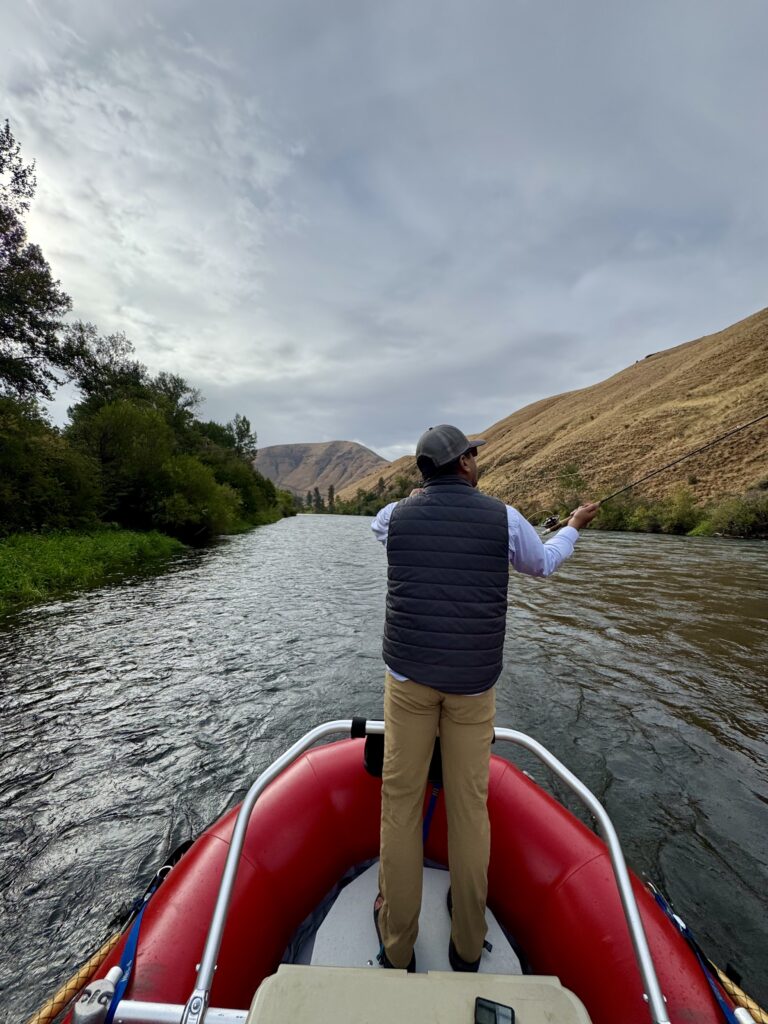
The first time I stepped into a drift boat, I thought it would be like wading with better positioning. I was wrong. Within the first hour, I’d tangled my line twice, missed obvious targets, and frustrated both my fishing partner and myself with poorly timed casts. The boat moved relentlessly downstream while I struggled to adapt techniques that worked perfectly from the bank.
That humbling experience taught me drift boat fishing isn’t simply wade fishing from a moving platform – it’s an entirely distinct discipline requiring its own skill set, timing, and strategic thinking. The angler who masters these waters learns to think three moves ahead, casting not to where fish are, but where they’ll be when the fly arrives.
The transformation from awkward passenger to effective boat angler doesn’t happen overnight, but the journey rewards persistence. Understanding these fundamentals will save you the frustration I experienced and fast-track your development into someone who can capitalize on drift boat fishing’s incredible opportunities.
Understanding Your Floating Platform
Drift boats come in various forms – classic hard-sided McKenzie boats, inflatable rafts, and pontoon-style vessels – but they all share the fundamental characteristic of moving with the current rather than fighting it. The distinction between using your boat as simple transportation versus an active fishing platform defines your entire approach to the day.
Real drift boat fishing means staying aboard while covering water, with someone on the oars maintaining optimal position as you work flies through productive zones. The rower’s job involves keeping the boat 20-30 feet from the bank – close enough for accurate presentations but far enough to avoid spooking fish with the boat’s shadow or movement.
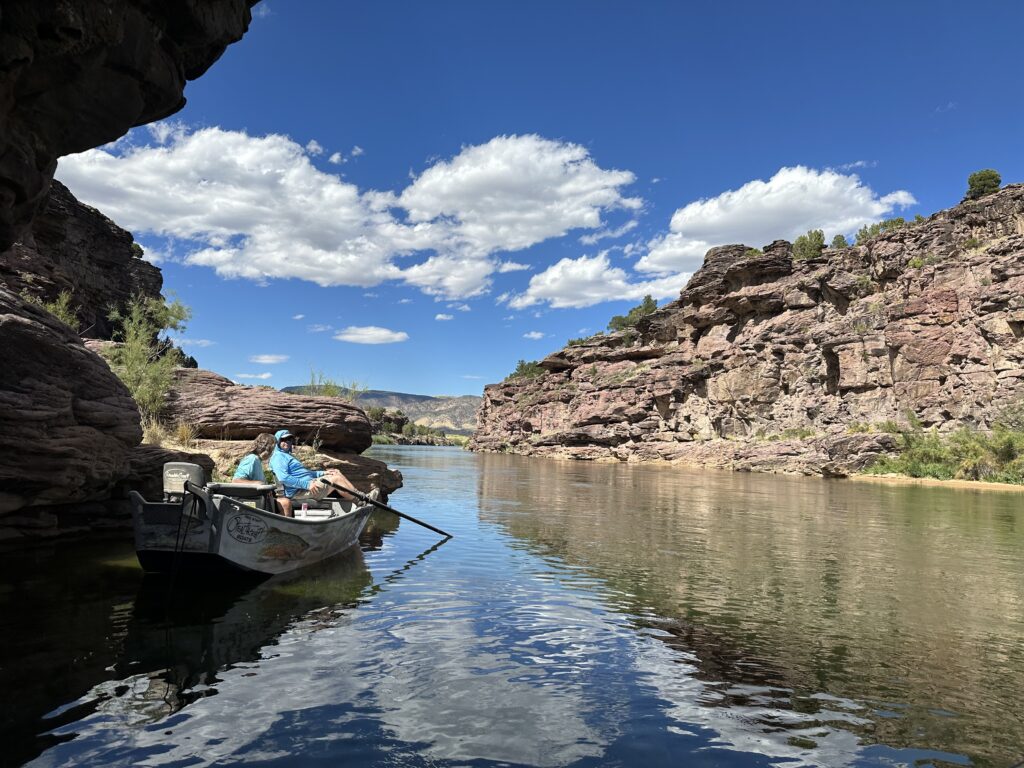
Safety considerations take priority over everything else. Each person aboard needs an accessible life jacket, and many states require wearing them at all times. Standing in most boats creates unnecessary risk unless the craft features proper knee braces designed for that purpose. A sudden rock impact or wind gust can send you overboard faster than you can react.
The boat’s layout creates distinct fishing zones. The stern faces upstream and typically houses the anchor, while the rower occupies the center position facing downstream to navigate effectively. Anglers fish from bow or stern positions, each offering unique advantages and challenges that require different approaches.
Gear That Makes the Difference
Standard fly fishing equipment adapts well to boat fishing, but specific choices dramatically impact your effectiveness. A 6-weight rod handles streamers and large terrestrials with authority, while a 5-weight excels with bigger dry flies and indicator setups. Having a 4-weight available for delicate presentations with smaller flies expands your options when conditions demand finesse.
Fly line selection becomes crucial due to the repetitive short-cast nature of boat fishing. Most presentations happen at 20-25 feet to the bank, followed by immediate pickup and recast – a rhythm that stresses lines differently than traditional fishing.
Streamer fishing benefits enormously from specialized streamer tip lines featuring weighted front sections and short front tapers. These lines excel at the rapid “cast-strip-pickup-recast” pattern that defines boat streamer fishing, delivering large flies with consistent accuracy at short range.
For terrestrial fishing – arguably the most exciting boat technique – front-loaded lines like weight-forward designs with aggressive tapers punch large, wind-resistant flies through challenging conditions. These lines prioritize speed and accuracy over distance, perfectly matching the demands of bank fishing.
Two gear modifications will improve your comfort and success significantly. Replace traditional fishing vests or hip packs with a boat bag that organizes gear without creating snag hazards in confined spaces. Choose a landing net with a longer handle than your wading net – boat sides require extra reach for effective fish handling.
Rigging Systems That Work
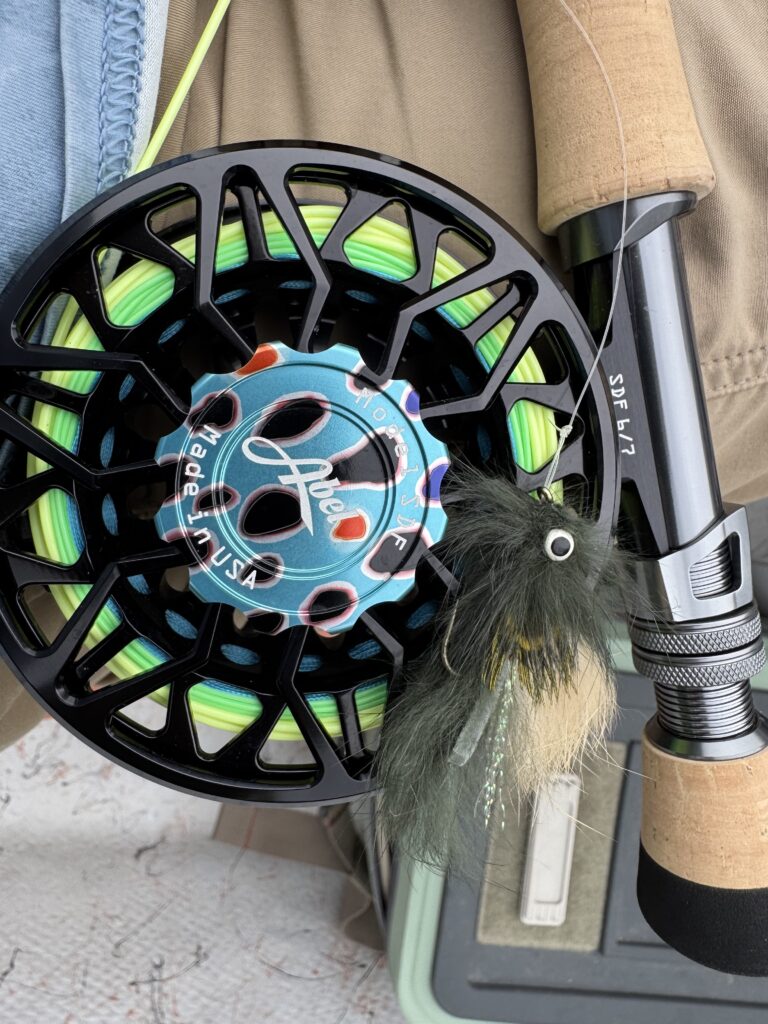
Streamers: Simplicity wins with single large streamers on 6-foot medium-stiff leaders. Cast tight to banks, make three or four aggressive strips, then immediately pick up for the next target. Don’t waste time retrieving flies back to the boat – productive water lies within 12 feet of the bank.
Terrestrials: Use identical leader setups as streamers. These patterns represent land-born insects like grasshoppers, ants, beetles, and large stoneflies that fall near shore. Success depends on landing flies within three feet of the bank with audible impact that mimics real insects hitting water.
Hopper-Droppers: This versatile combination places large dry flies on leader ends with weighted nymphs suspended 18-24 inches below from hook bends. Fish these rigs by drifting them down current seams like traditional indicator setups, or cast tight to banks where trout might take either surface flies or subsurface droppers.
Nymph Rigs: Classic indicator nymphing adapts perfectly to boat fishing. Standard setups with preferred indicators, tippet rings, and one or two nymphs spaced 12-24 inches apart allow extensive water coverage with minimal recasting, maximizing fish contact over long floats.
Casting from a Moving Platform
Boat casting requires fundamental modifications to standard techniques. The cornerstone principle involves casting downstream – never perpendicular to current, and absolutely never upstream. Downstream casting keeps leaders and lines below flies where fish can’t see them, enables better fly manipulation, and provides natural drag-free drifts when executed properly.
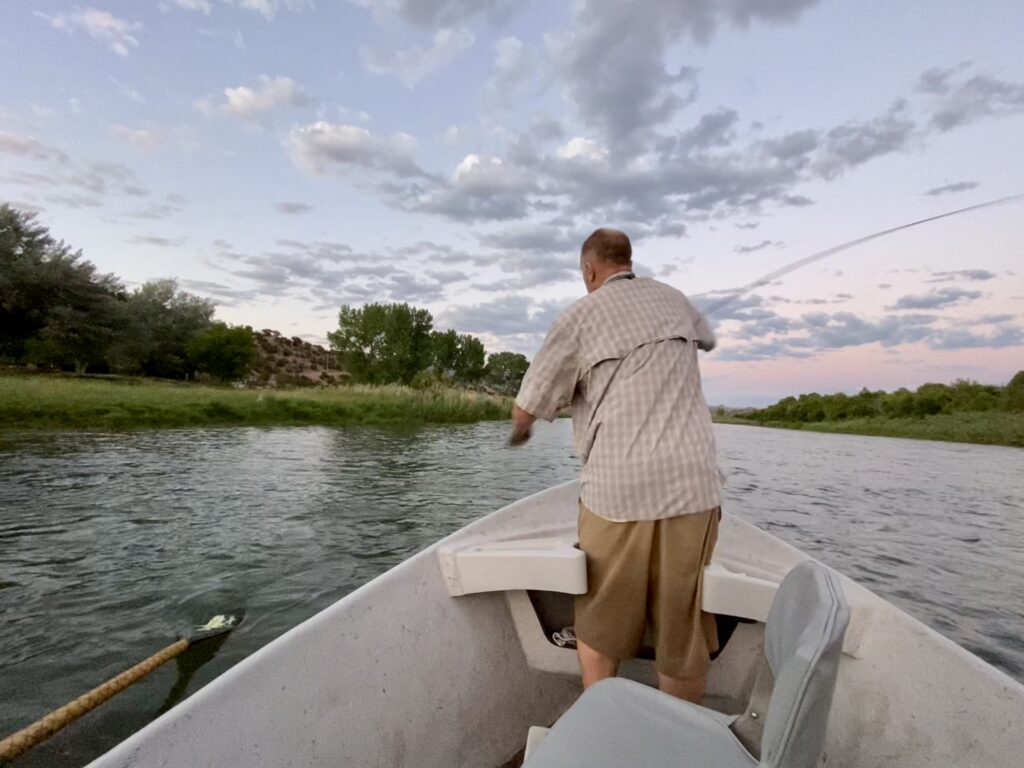
Distance control becomes critical when fishing from moving platforms. Unlike leisurely wade fishing pace, boat fishing provides only seconds to identify targets, deliver flies accurately, and work them effectively before current carries you past. Developing ability to hit paper plate-sized targets consistently at 15-35 feet separates successful boat anglers from frustrated ones.
Compact casting strokes focused on elbow movement rather than full-arm motion prove most effective. Think precision over power – you’re making delicate chip shots, not driving balls 300 yards. Short, controlled strokes from 12 o’clock to 10 o’clock generate tremendous line speed while maintaining surgical precision. Keep your casting-side foot slightly forward to prevent opening up your stance, and maintain traditional thumb-over grips for optimal line control.
Casting planes must adjust for boats’ elevation above water. Throw backcasts high like steeple casts, then drive forward casts down toward water with velocity. Don’t worry about surface impact – in windy conditions, low, fast delivery proves far more accurate than delicate presentations that wind destroys.
The “stop and drop” technique becomes essential: make high, hard stops on forward casts, then immediately lower rod tips to create slack. This allows flies to continue drifting naturally without immediate drag – often the difference between fish that eat and fish that flee.
Speed development proves critical as skills advance. Rivers don’t wait for perfect casts. Limit false casting to one maximum, using it only to work out line inconsistencies from water pickups, then deliver immediately to targets. Practice exchanging line between rod hands and stripping hands until movements become automatic.
Productive Fishing Techniques
Terrestrial Mastery
Summer and early fall terrestrial fishing from boats produces some of fly fishing’s most explosive action. The technique appears simple but demands precision: cast large grasshopper, ant, beetle, or stonefly patterns as close to banks as physically possible, ideally within 18 inches of shore.
Presentation keys lie in authoritative delivery – audible “plops” aren’t mistakes but essential elements. Fish positioned along banks listen for terrestrials hitting water and investigate disturbances. Missing banks by four feet instead of one dramatically reduces success rates.
Work systematically down shorelines, hitting every promising pocket, undercut bank, and grass tuft with surgical precision. Don’t linger on individual casts – if fish don’t respond within three seconds, pick up and cast to next targets. Constant motion rewards aggressive, efficient coverage over patient, methodical presentations.
Streamer Effectiveness
Boat streamer fishing allows covering vast productive water while targeting rivers’ most aggressive predators. Large, flashy patterns creating significant displacement work best in varied light conditions encountered while drifting.
Cast streamers tight to banks and immediately begin authoritative stripping. Three or four aggressive strips get fish attention – interested trout commit quickly. Don’t work streamers back to boats; pick up after 10-12 feet and cast to next likely holding spots.
Vary retrieve speeds and patterns based on water temperature and conditions. Colder water often rewards slower strips over aggressive retrieves, while warm summer conditions frequently favor fast, erratic movements triggering predatory responses.
Dry Fly Precision
Boat dry fly fishing demands constantly looking ahead, identifying targets before reaching them rather than reacting to water immediately beside boats. Train yourself to spot current breaks, depth changes, shade lines, and structure concentrating feeding fish.
When identifying rising fish or particularly productive water, don’t hesitate to anchor boats. Unlike other boat techniques relying on constant motion, effective dry fly fishing often requires multiple casts to same targets. Anchored boats provide time and positioning stability necessary for working selective trout.
Focus on natural drift above all else. Use reach casts and aerial mends to manipulate line positions during casts, reducing need for on-water mending that can spook fish in clear, shallow water where most dry fly opportunities occur.
Advanced Presentation Methods
Master “walking the dog” – using subtle rod movements to guide flies away from obstacles while maintaining natural drift. When flies drift near logs, rocks, or overhanging vegetation, gentle upstream pressure keeps them in fishable water longer without creating unnatural drag.
Learn to lay tippets across submerged sticks or logs, allowing flies to hang in otherwise inaccessible pockets. When fish take, tippets slide off obstacles naturally, creating hookups in water that seems impossible to fish effectively.
Develop “pull and shoot” casting for fishing behind obstacles. Instead of working flies around trees or rocks, pick up and fire casts directly behind structures, accessing water conventional casting can’t reach.
Positioning and Boat Coordination
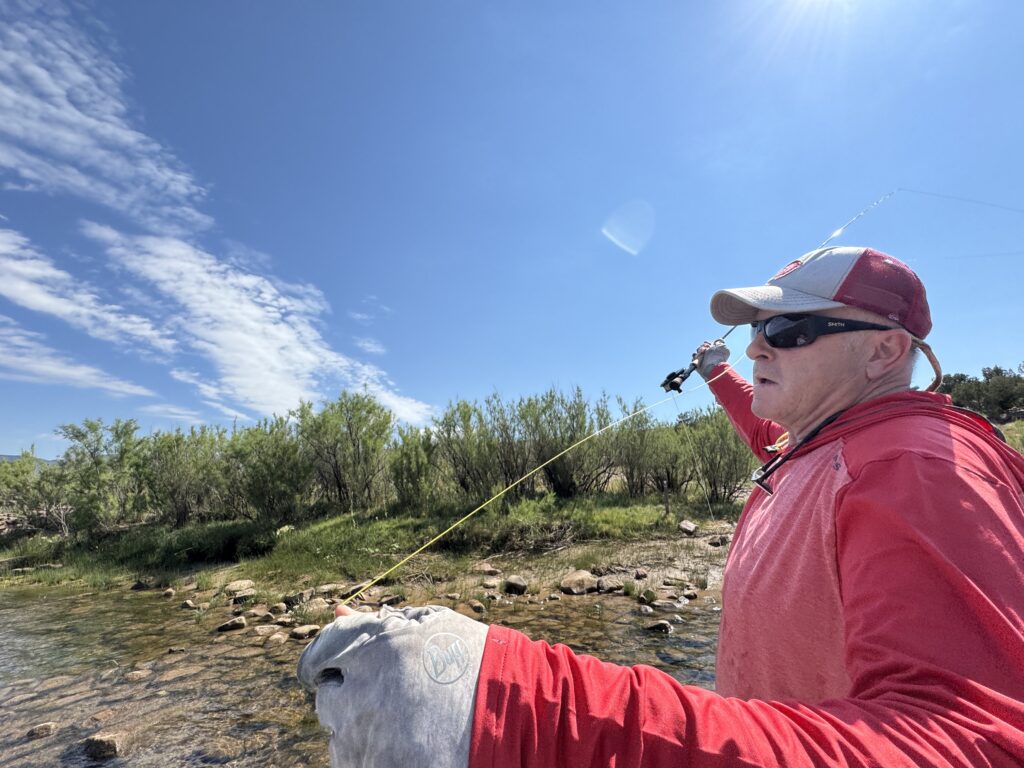
Front Position Advantages
Bow positions offer prime water access but come with significant responsibility. You set fishing pace and rhythm for entire boats. Always look downstream, identifying targets well before reaching them. Don’t focus on water immediately adjacent to boats – by the time you see it, it’s too late for effective fishing.
Respect invisible boundaries at rowers’ positions. Water downstream of oars belongs to bow anglers; water upstream belongs to stern anglers. Resist temptation to work promising spots too long – there’s always more productive water ahead, and monopolizing prime areas creates tension and reduces everyone’s success.
Develop ability to cast off both sides of your body. When fishing opposite your dominant casting side, either learn off-hand casting or master backhand casting techniques. Never cast over rowers – it’s dangerous and poor etiquette.
Back Position Strategy
Stern positions offer unique advantages despite some calling them “penalty boxes.” You can make multiple casts to promising targets after they pass oars, and often get shots at water bow anglers missed or couldn’t reach effectively.
Watch bow anglers’ casting rhythms carefully to avoid tangles. When you see them preparing to cast, hold rods low until their flies hit water, then make presentations. Coordinate efforts to fish parallel lines rather than crossing streams.
Focus on water slightly further from banks than bow anglers cover. If they’re hitting prime shoreline structure, punch casts 5-8 feet further out to cover different water and maximize boats’ fishing effectiveness.
Stay aware of anchors and their potential to snag lines. Stern positions require constant attention to this hazard, but also offer unique opportunities to fish upstream pockets only accessible from behind.
Avoiding Common Pitfalls
Many experienced wade fishermen make predictable errors when transitioning to boat fishing. Understanding these pitfalls accelerates learning curves and prevents frustrating days on water.
The most frequent mistake involves casting perpendicular to current or upstream. This creates immediate drag and severely limits fly effectiveness. Force yourself to cast downstream at minimum 45-degree angles, even when it feels unnatural initially. Success rates improve dramatically once this becomes automatic.
Many anglers waste precious time with excessive false casting. Unlike wade fishing where patience pays dividends, boat fishing rewards quick decisions and immediate execution. Train yourself to make one false cast maximum, using it only to work out line inconsistencies from water pickups.
Line management becomes critical in boats’ confined spaces. Anglers frequently tangle themselves in loose line or catch fly lines on boat hardware. Keep lines organized and maintain awareness of anchor brackets, coolers, and other snag hazards. Practice line exchanges until they become second nature – fumbling with line while fish are rising costs opportunities.
Another common error involves fishing water that’s already been covered. Communication between bow and stern anglers prevents duplicate efforts and maximizes boats’ effectiveness. Establish clear boundaries and stick to them throughout floats.
The Complete Approach
Mastering boat fly fishing requires developing skills beyond traditional casting and presentation. You must think strategically about water coverage, timing, and coordination with boat partners. Rivers never stop moving, and neither can decision-making processes.
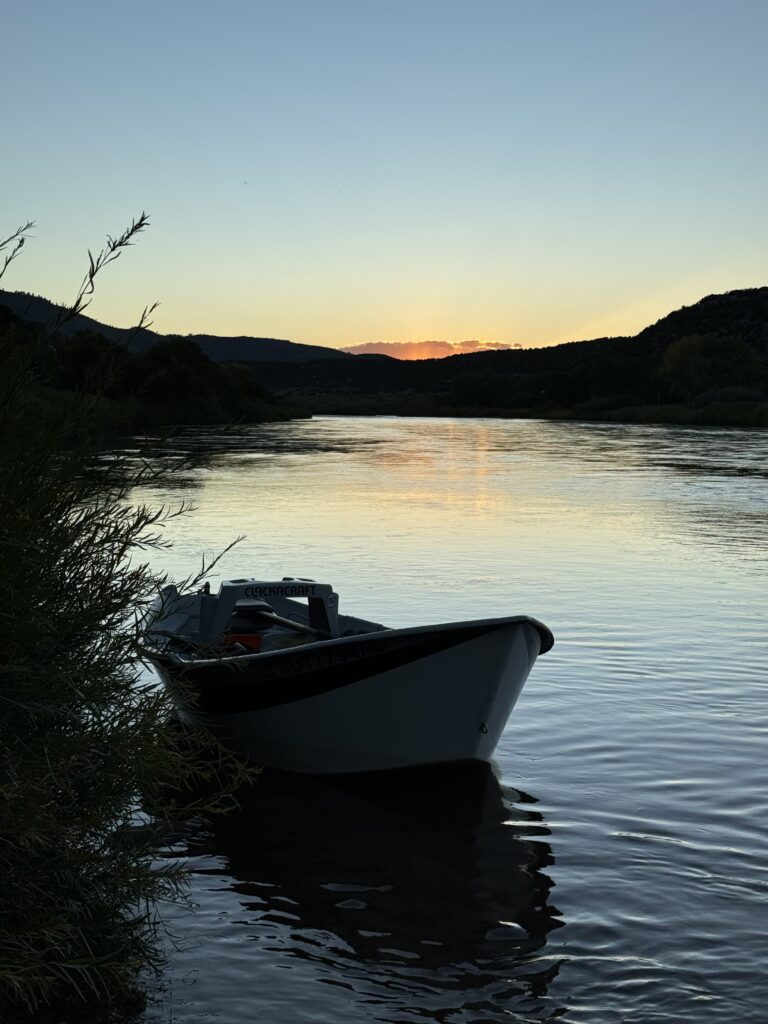
Practice these techniques on every trip, starting with fundamentals and gradually incorporating advanced presentations as comfort levels increase. Focus on consistency over complexity – perfectly executed basic techniques outproduce poorly executed advanced ones every time.
Most importantly, embrace the unique challenges and opportunities boat fishing provides. The ability to cover miles of productive water, access otherwise unreachable fish, and experience constantly changing scenery makes this one of fly fishing’s most rewarding disciplines.
The next time you step into a drift boat, remember that you’re not just a passenger being transported between fishing spots – you’re an active participant in one of angling’s most dynamic and effective approaches. Master these fundamentals, and every float becomes an opportunity for the kind of fishing memories that last a lifetime.